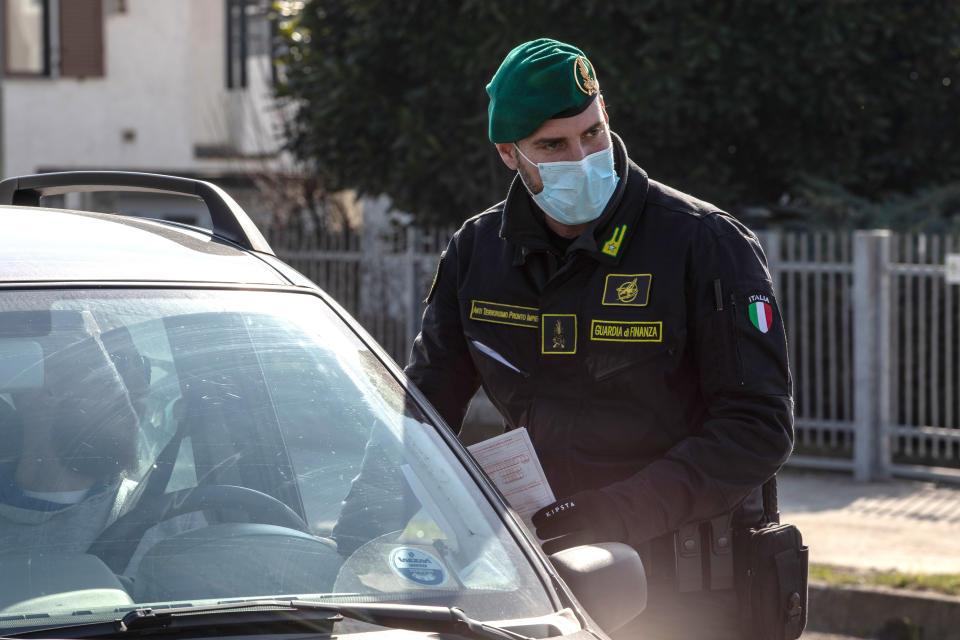Coronavirus Covid-19 'does not meet the definition of a pandemic'

The coronavirus Covid-19 cannot yet be considered a “pandemic”, officials have said.
The previously-unknown strain emerged at a seafood and live animal market in the Chinese city Wuhan at the end of last year.
It has since crossed national borders into more than 20 countries, with 13 cases reaching the UK.
Read more: Coronavirus Covid-19 'mild' in more than four in five cases
Out of the more than 79,500 confirmed incidences worldwide, 77,150 are in mainland China, according to John Hopkins University data. The country’s death toll exceeded 2,500 on Monday.
The infection is taking hold thousands of miles away from its epicentre, with 833 cases and eight deaths in South Korea alone.
Italy is faring worse than anywhere else in Europe, with its 215 patients and six deaths prompting several small towns in the Lombardy and Veneto regions to be put on “lockdown”.
All this means not everyone is convinced by the officials’ reassurance, with one expert calling the outbreak “a pandemic in all but name”.

What is a pandemic?
A spokesperson from the World Health Organization (WHO) claims it no longer declares outbreaks a “pandemic”.
It made Covid-19 a “global emergency” on 30 January after people who had not visited China caught the virus from those who had recently been.
According to the WHO’s old definition, a pandemic is the “worldwide spread of a new disease”.
For example, a virus that emerges and travels globally, with most people having no immunity.
Unlike seasonal infections - such as flu - anyone can be vulnerable to a “pandemic”, even the young and otherwise well.
Swine flu, the first “global emergency”, caused “most of its severe or fatal disease in younger people, both those with chronic conditions, as well as healthy persons”.
The vast majority of Covid-19 fatalities reported so far have been in the elderly or otherwise ill.
Lack of immunity tends to make infections have greater “impact or severity”.
In extreme cases, Covid-19 triggers pneumonia.
This comes about when the air sacs (alveoli) in the lungs become inflamed and filled with pus or fluid.
“Without treatment the end is inevitable,” said the charity Médecins Sans Frontières.
“Deaths occurs because of asphyxiation.”
Read more: How is the coronavirus Covid-19 diagnosed?
Nonetheless, scientists from the Chinese Center for Disease Control and Prevention (CCDC) found early cases of Covid-19 were “mild” in four out of five cases.
Covid-19’s death rate is up for debate.
A report by the CCDC estimated the province Hubei - of which Wuhan is capital - has a fatality rate of 2.9%, compared with the rest of China’s 0.4%.
Overall, it predicted a 2.3% death rate.
Earlier this month, scientists from Imperial College London calculated Hubei’s “case-fatality rate” could range from 1% up to 18%.
They noted the “credible interval” goes from 11% up to 81%.
Among “travellers outside mainland China”, the case-fatality rate was estimated at between 1.2% and 5.6%, with “substantial uncertainty”.
Taking into account both asymptomatic and symptomatic incidences, the Imperial scientists calculated the likely overall case-fatality rate to be around 1%.
The WHO previously defined pandemics as potentially following “unusual epidemiological patterns”, with some being surprisingly worse in summer.
Yahoo UK reported, however, Covid-19 may ease as it gets warmer, before re-emerging in the northern hemisphere’s winter.
Overall, the UK is “well prepared” to deal with the infection, with the risk to individuals “remaining low”, the BBC reported.
Sir Simon Stevens - head of the NHS - warned, however, more people will likely have to “self isolate” to stem the spread of infection.
The WHO’s director-general Dr Tedros Adhanom Ghebreyesus said on Friday the window of opportunity to contain Covid-19 was “narrowing”.
Symptoms tend to be flu-like and vague, namely fever, cough and breathlessness.
Patients may be infectious before they feel ill and “carry” the virus unknowingly for more than 14 days.
While the WHO no longer officially uses the term “pandemic”, it may be said “colloquially”.
A spokesperson told the BBC: “If it became clear [Covid-19] is all around the globe and we are seeing systematic community transmission, then we would say this meets the definition of a pandemic.”
She added countries are “managing to prevent the virus spreading too far” for now.
Speaking at a Covid-19 briefing, Dr Adhanom Ghebreyesus said: “For the moment we are not witnessing the uncontained global spread of this virus and we are not witnessing large-scale deaths.
“Using the word pandemic does not fit the facts.
“Does this virus have pandemic potential? Absolutely, it has.
“Are we there yet? From our assessment, not yet.”
Read more: How to stay calm amid the coronavirus Covid-19 outbreak
Not everyone is convinced, however.
“We now consider this to be a pandemic in all but name and it’s only a matter of time before the WHO starts to use the term in its communications,” said Dr Bharat Pankhania from the University of Exeter.
Professor Mark Woolhouse from the University of Edinburgh, added: “A pandemic means an infectious disease is spreading out of control in different regions of the world.
“We already have a Covid-19 epidemic in China and, more recently, large outbreaks in South Korea, Iran and Italy.
“If those outbreaks cannot be brought under control, then I would expect the WHO to declare a pandemic.
“The immediate implication is many different countries around the world may be sources of Covid-19 infections.
“This will make large and difficult to control outbreaks more likely in the UK and many other countries.”
Professor David Heymann, from the London School of Hygiene & Tropical Medicine, called the term pandemic “distracting”.
“What is necessary is to understand the current situation in each country”, he said.

What is the new coronavirus Covid-19?
Covid-19 is one of seven strains of the coronavirus class that are known to infect humans.
Others range from the mild common cold to the severe acute respiratory syndrome (Sars) outbreak that killed 774 people in 2004.
Most of the people who initially became unwell worked at, or visited, the Wuhan market.
The only know method of transmission is face-to-face via infected droplets that have been coughed or sneezed out.
While no one can say for sure where the virus came from, bats seem most likely.
The nocturnal creatures are thought to have been behind Sars and fellow coronavirus Middle Eastern respiratory syndrome (Mers).
Scientists from Peking University in Beijing suggested snakes may have been the “intermediate host” for Covid-19.
A team from South China Agricultural University have since found it could have “jumped” from bats to humans via pangolins.
To prevent infection, the NHS recommends regular hand washing and avoiding those with suspect symptoms.



